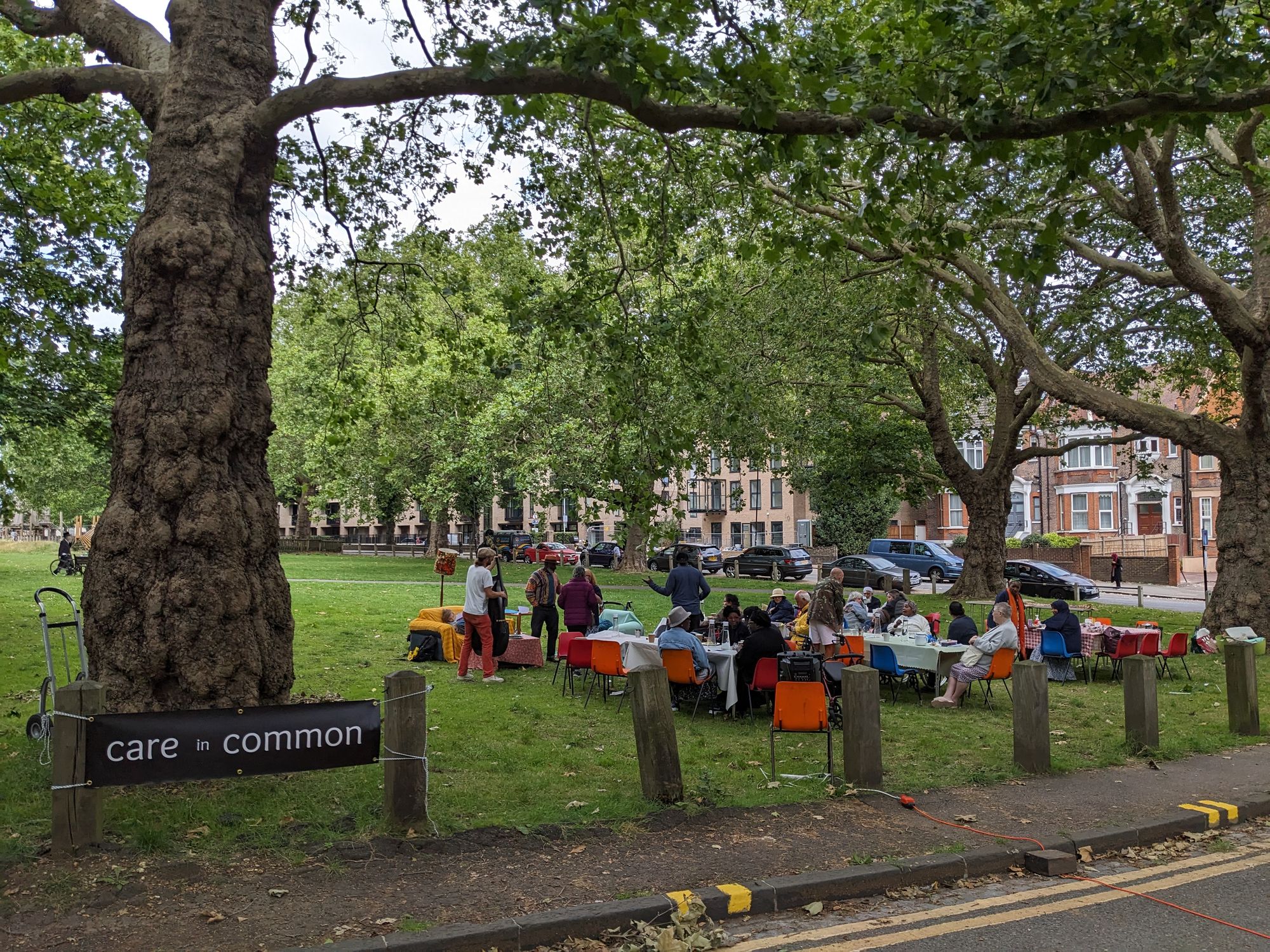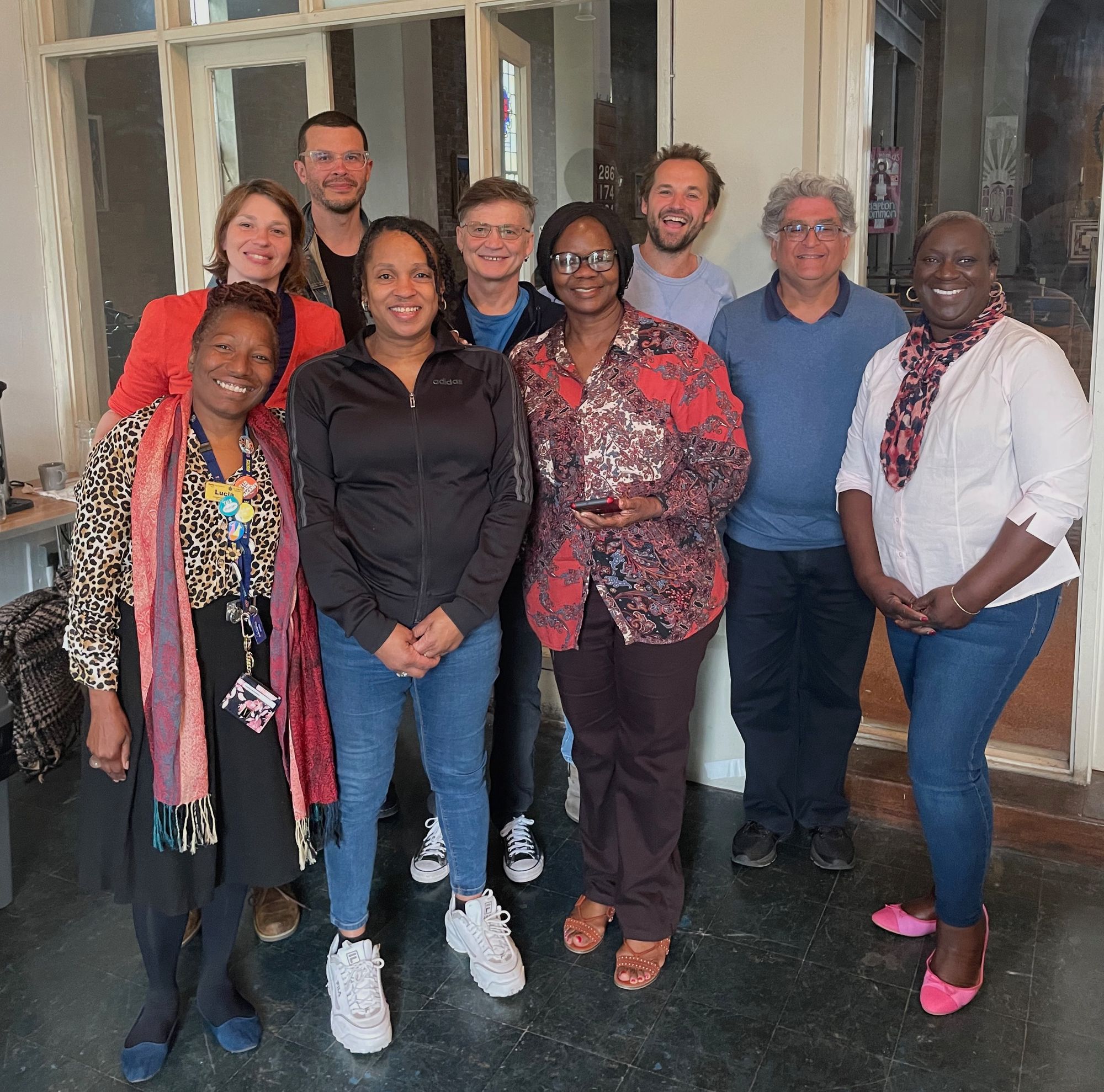Mapping a local landscape of care and belonging, Clapton Common

Equal Care Coop and Clapton Commons are mapping a local landscape of care and support in Clapton Common, Upper Clapton. Using KUMU, a powerful system mapping platform, we are creating an interactive map that makes the often invisible grassroots networks of care and support more visible and accessible to people giving and receiving care.
We will be using this map to:
- Generate more cooperative connections between local groups and organizations and facilitate the sharing and pooling of resources for their common good.
- Enable local community groups to enrich the quality of lives of members of equal care teams and for those teams, in turn, to enrich the local landscape of care and belonging
- Make a local gift economy that promotes individual and community well-being more visible and accessible
- Help people spend more of their money on care within the local community
- Promote asset-based community development in Upper Clapton by matching local resources to local needs and aspirations
- Measure the social impact of our pilot in commons-based care on the local community.
Care Network, Clapton Common
Care in Common
This map is a relationship map not a map of a geographical area. The relationships it maps are located in neighborhoods around Clapton Commons. In fact, most of the relationships represented in this map have been forged through face-to-face interactions at community events, informal meetings or chance encounters on the common or the community spaces in Lime Tree Court and St Thomas Church (situated on either side of the common). Everyone on this map shares a common purpose related to care, which includes “Taking care of,” “Caring for,” and “Caring about” individuals’ well-being and needs.
This map is not an exhaustive list of organisations, groups or services offering these forms of care in the area. There are lots of groups and services in upper Clapton that don't currently appear on this map. Organisations, groups, and services are mapped if or when one or more of their representative members are:
- named by our team owners as actors in their own personal care networks within our care mapping team-building process
- collaborating with the Clapton Care Circle community to help build and or resource Equal Care teams
- Coordinating and or resourcing community events/actions that are strengthening the local network we are mapping/ developing
This criteria for inclusion reflects our commitment to the core activities in the pilot of our commons-based approach to home care; engaging local residents looking for better care and support; facilitating care mapping as part of our team building process; launching 5 self-managing care teams; developing cooperative connections between teams and local community networks that enrich quality of life.
Situating the mappers
This map has inherent biases based on project objectives, the organisational values, interests, and cultural perspectives of the group leading the project as well as the individual mappers Luke Tanner (equal care coop), Marcus Duran (Clapton Commons) both co-founder of the Clapton Circle.

Upper Clapton is a complex and rich neighborhood, defined by a breadth of cultures, Kurdish, African, Caribbean, and the largest Orthodox community in Europe. In bringing one set of relationships to the fore, it can be argued that we are obscuring others. Mappers from other community groups, following a similar mapping process, would uncover different grassroots support networks, revealing a landscape of care and belonging unique to them. We aim to do more than just highlight existing bonds within a community; we want to build bridges between different communities for their mutual benefit. Additionally, we hope this map will become a useful tool for other other groups to pursue their goals. Initially, however, our focus will be on developing features that align with our core project objectives.
Key features of the map
The KUMU platform is extremely flexible and offers a range of features that enable us to represent and analyse intricate relationships and complex networks. To begin we are keeping things simple, adding complexity only when practical use demands it. The map within this blog is interactive so you can click on any elements or connections to experience the map discussed below. In its current form, the key features of the map include:
ELEMENTS: These are the dots on the map. There are currently 3 types of elements:
- Organisation; a broad category encompassing local services, such as Old Hill School, religious centers, such as St Thomas Church and community organisations such as Clapton Commons, or businesses such as Muisca coffee shop.
- Group; refers to unincorporated collectives such a neighborhood support or mutual aid groups, litter picking groups, meditation groups, etc.
- Team; represents the equal care teams participating in our pilot project. Teams are built with the person we support and are made up of friends, family members, peers, neighbors and care workers. A parallel mapping process, Atlas Caremaps, informs our team-building approach. Whenever possible team members are made up of some of the key actors in someonecare map. We then engage organisations and community groups represented in the KUMU map to recruit local care workers into these teams.
Clicking on a given element reveals information about why the element has come to be on the map as well as what it is giving to and getting from the network.
CONNECTIONS: These are the lines on the map connecting elements. Unlike elements, there are no categories of connections. We don’t know what categories of connections are useful yet. As we use the map and consult members of the network we will discover what kinds of categories are needed. The current criteria for mapping a connection between elements is 1. mutual consent to their connection being represented on the map and 2. a common understanding of their plans for and outcome of the collaboration. The connections that don't currently meet this threshold are represented by a dashed line (we still have lots of work to do!). Clicking on a connection reveals information about the collaboration as well as an outline of any pledges to one another i.e. the gifting of a concrete asset or resource.
A relationship-centred paradigm of care
The connections between elements on this map are as vital as the elements themselves. Instead of just describing organizations, this map highlights their past, present, and potential roles within the network. This approach aligns with the principles of interdependency and reciprocity that underpin our relationship-centered model of care. When applied to living systems these principles recognise that
- Individuals are nested within greater and lesser systems e.g. individuals are nested within households/families, families/households nested within neighborhoods/communities, etc.
- Every life form grows and expresses itself to benefit of the living systems it is embedded within and from which it receives benefit from in return.
In this paradigm of care, an Individual’s well-being is dependent on the quality of their relationships. The quality of life of the people we support in our teams is dependent on the quality of lives of the team members. Teams thrive through mutually beneficial cooperative connections with other teams, groups or organisations in the network. Performance improvement of any one element of the network is only sustainable to the extent that it is part of a larger, reciprocal value-adding process. This way of thinking brings together individual well-being and the well-being of the community they are nested within. When formal systems of care (like our regulated care service ) and informal systems (like grassroots care and kinship networks ) work together, it creates a richer and more supportive environment for everyone.
Care wealth and community networks
Caregiving and nurturing actions not only meet immediate needs but also build social capital, enhancing overall well-being. This map showcases stories of relationship building, their significance, outcomes, and community impact, representing the collective strength and value of social bonds formed through caregiving. The relatedness, care, generosity, trust, accountability, and belonging that is generated through ongoing care and support, define a kind of "Care Wealth." This resource is primarily generated from within the non-commodified spheres of informal care and support. It is often overshadowed by the financial and physical capital generated through the exchange of goods and commodities in the market. Care Wealth, however, is vital for community well-being and resilience and can lead to these other forms of capital through the sharing of tangible physical and economic resources and assets.By clicking on connections, you can see examples of this, from local businesses providing free meals to team members, to team members donating skills and time to local community organizations. Our commons model of care seeks to engage this Care Wealth to enhance people's quality of life within our service. It's also the resource we aim to help generate to strengthen local community networks' well-being and resilience.
Mapping a local Care Commons
In making a community network and it’s care wealth more visible and accessible this map also uncovers the key features of a local care commons;
A care commons = a community care and support network + it’s care wealth + a system for the collective stewardship of this shared resource
Mapping is actually helping to build this care commons. In developing this map we are engaging in structured conversations with members of each element of the map that invites them to reflect on the role they can play in the making, provisioning, and stewardship of a vital community resource. Having consented to engage in this process and share information on our map, participants are invited to become formal members of Care in Common, the name of this community care network and to appoint someone to become their representative member of Care in Common. These members are invited to attend period meetings to shape the Care Commons' core purpose and coordinate its ongoing maintenance and development.
Upon the successful launch of equal care teams, we can begin to assess the role this care commons can play in transforming people’s experience of social care. Each team will not only be shaped by the Care Commons, but also help shape it. Launching each team begins with mapping their personal care network. Just as key people in someone’s care map can become a member of their team, so too can key groups and organisations become a member of the care commons. This commons-based co-production of care gives rise to a service that belongs to the people in two senses. Firstly, the service is made up of the very people, places, and things that matter most to the people using the service and which shape their sense of belonging. Secondly, the service itself actually belongs to the people who use it through a cooperative model of ownership.

